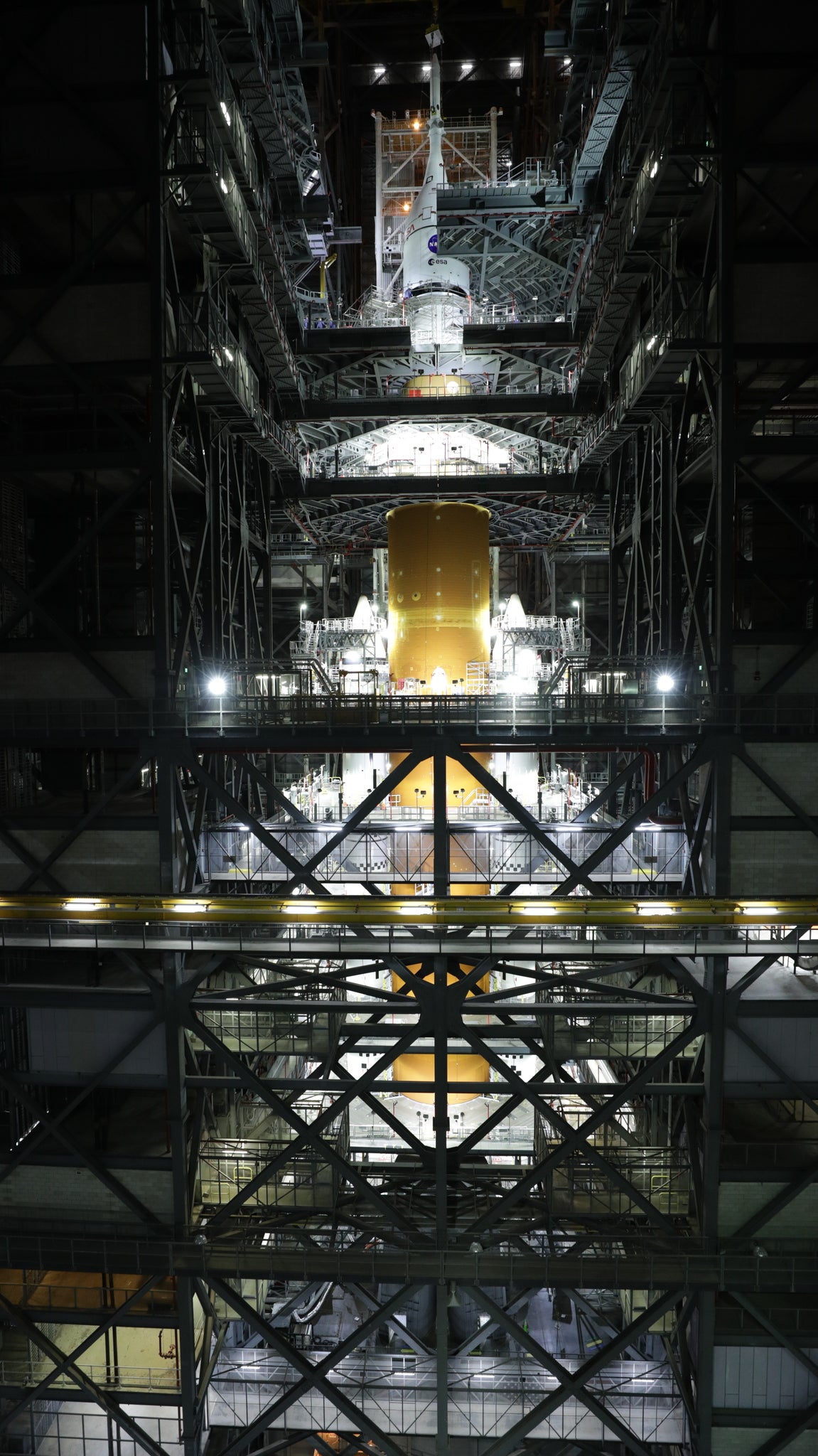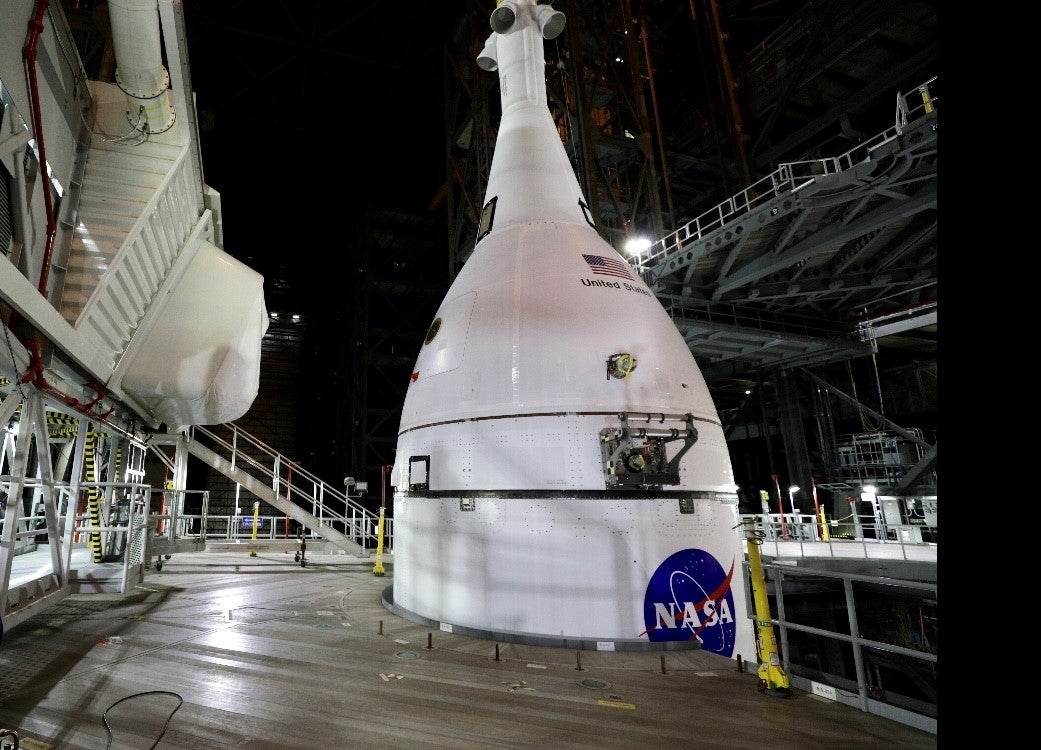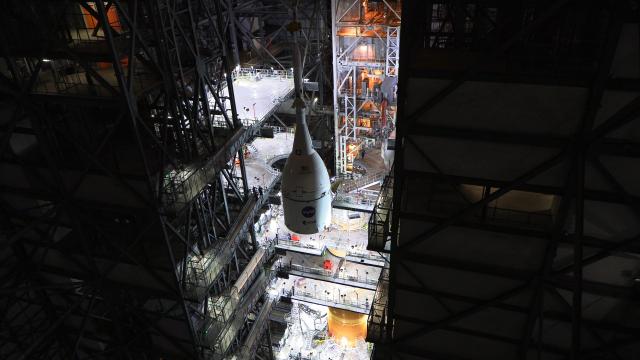Like a cherry placed atop a delicious sundae, NASA technicians have successfully mounted the Orion spacecraft onto the Space Launch System rocket. It’s a major milestone, as the space agency prepares for the upcoming Artemis missions to the Moon.
The completed stacking of the SLS rocket has resulted in a structure that stands 332 feet (101 meters) tall. A team of NASA engineers and technicians finished the installation at NASA’s Kennedy Space Centre in Florida shortly before midnight on October 21. The launch abort system was also secured to the rocket, in addition to the 74,000-pound (33.5-metric ton) Orion spacecraft. The stacking process started earlier this year, and its completion represents a major milestone for NASA.

Speaking to reporters earlier today, Mike Bolger, the exploration ground systems program manager at Kennedy Space Centre, was amazed to see the structure from top to bottom, describing it as a “heck of a sight.” The rocket is currently parked inside NASA’s Vehicle Assembly Building (VAB), and Bolger said he’ll be even more stoked once the rocket is rolled out to the launch pad.
Cathy Koerner, Orion program manager at NASA’s Johnson Space Centre, said her team performed extensive testing on Orion to make sure it was ready for the roll-out. The Artemis I mission will represent Orion’s second flight to space, but it will mark the spacecraft’s first journey to deep space. During the teleconference, Koerner said she’s “excited to watch Orion work in the environment it was designed for.”
Indeed, we’re getting close to the inaugural blast-off of this next-gen moon rocket — the much-anticipated mission known as Artemis I. For this upcoming test flight, the rocket will deliver an uncrewed Orion capsule to space, where it will travel to the Moon and back without a lunar landing. A successful test will set the stage for Artemis II at some point in 2023, an identical mission save for the presence of actual NASA astronauts.
That we’re getting close to Artemis I was made abundantly clear during today’s teleconference, as actual launch dates were provided. Mike Sarafin, Artemis I mission manager, said the earliest that SLS could launch is February 12, 2022, at 5:56 p.m. EDT (February 13, 2022, at 8:56 am AEDT). The overarching launch window will remain open until February 27. If SLS can’t launch in February, NASA will try again between March 12 to 21 and again between April 8 to 23.
The reason for the two weeks on and two weeks off pattern has to do with the so-called “three-body problem”; as Sarafin explained, the launch window is dictated by the position of Earth on its axis, the lunar cycle, and the need for a daylight splashdown back on Earth.

These proposed launch dates are contingent upon a series of upcoming tests and ongoing evaluations, including verification of the communications system, countdown tests and tests of the ground systems, as well as a wet dress rehearsal in which propellant will be added to the rocket’s fuel tanks. No firm date was given for the wet dress rehearsal, but Tom Whitmeyer, the deputy associate administrator for exploration systems development, said the wet rehearsal will ideally happen in January.
“I’m very excited about the tremendous progress we’ve made, especially given the challenges presented by covid,” Whitmeyer told reporters. But he cautioned about the dates saying “we’re gonna fly when the hardware is ready to fly.”
At the press conference, John Honeycutt, SLS program manager at NASA’s Marshall Space Flight Centre, said the team is ready to finish testing and go about the integration work. Artemis I will not only be the first test launch of SLS, but the first test of many new ground systems, he added.
Sarafin said the completed stacking is an important milestone and that it signals the final stretch. He warned that Artemis I won’t be a cakewalk, pointing to such challenges as operating Orion under true flight conditions, returning it from the Moon and performing a safe re-entry (the capsule will go from Mach 32 to Mach 0 in 20 seconds), and retrieving the spacecraft for inspection. Bonus objectives, he said, include the deployment of 10 cubesats, including the BioSentinel study to study the effects of space radiation on yeast.
Excitingly, Sarafin said Orion will be equipped with cameras, and he’s anticipating selfies taken with the Moon in the background, along with spectacular views of Earth from distances exceeding 200,000 miles (322,000 km).
Artemis I and II are test missions for the ultimate prize: a crewed landing on the surface of the Moon, which is currently scheduled for 2024 (though that seems increasingly unlikely). A key goal of Artemis is to ensure a long-term and sustainable presence on the Moon that will help to prepare for a mission to Mars during the 2030s.
More: Unfinished Spacesuits Means Astronaut Moon Landing in 2024 Is Almost Certainly Not Going to Happen.
